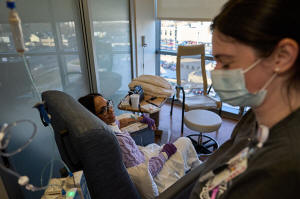There are more than 100 autoimmune diseases, and they mostly strike
women. Here's what to know
[November 07, 2025]
By LAURAN NEERGAARD
Our immune system has a dark side: It’s supposed to fight off invaders
to keep us healthy. But sometimes it turns traitor and attacks our own
cells and tissues.
What are called autoimmune diseases can affect just about every part of
the body – and tens of millions of people. While most common in women,
these diseases can strike anyone, adults or children, and they’re on the
rise.
New research is raising the prospect of treatments that might do more
than tamp down symptoms. Dozens of clinical trials are testing ways to
reprogram an immune system-gone-rogue, with some promising early
successes against lupus, myositis and certain other illnesses. Other
researchers are hunting ways to at least delay brewing autoimmune
diseases, spurred by a drug that can buy some time before people show
symptoms of Type 1 diabetes.
“This is probably the most exciting time that we’ve ever had to be in
autoimmunity,” said Dr. Amit Saxena, a rheumatologist at NYU Langone
Health.
Here are some things to know.
What are autoimmune diseases?
They’re chronic diseases that can range from mild to life-threatening,
more than 100 with different names depending on how and where they do
damage. Rheumatoid arthritis and psoriatic arthritis attack joints.
Sjögren’s disease is known for dry eyes and mouth. Myositis and
myasthenia gravis weaken muscles in different ways, the latter by
attacking how nerves signal them. Lupus has widely varied symptoms
including a butterfly-shaped facial rash, joint and muscle pain, fevers
and damage to the kidneys, lungs and heart.
They’re also capricious: Even patients faring well for long periods can
suddenly have a “flare” for no apparent reason.

Why autoimmune diseases are so difficult to diagnose
Many start with vague symptoms that come and go or mimic other
illnesses. Many also have overlapping symptoms – rheumatoid arthritis
and Sjögren’s also can harm major organs, for example.
Diagnosis can take multiple tests, including some blood tests to detect
antibodies that mistakenly latch onto healthy tissue. It usually centers
on symptoms and involves ruling out other causes. Depending on the
disease it can take years and seeing multiple doctors before one puts
the clues together. There are efforts to improve: The National MS
Society is educating doctors about newly updated guidelines to
streamline diagnosis of multiple sclerosis.
How the immune system gets out of whack
The human immune system is a complex army with sentinels to detect
threats like germs or cancer cells, a variety of soldiers to attack
them, and peacemakers to calm things down once the danger is over. Key
is that it can distinguish what’s foreign from what’s “you,” what
scientists call tolerance.
Sometimes confused immune cells or antibodies slip through, or the
peacemakers can’t calm things down after a battle. If the system can’t
spot and fix the problem, autoimmune diseases gradually develop.
[to top of second column]
|

 Autoimmune diseases are often set
off by a trigger
Most autoimmune diseases, especially in adults, aren’t caused by a
specific gene defect. Instead, a variety of genes that affect immune
functions can make people susceptible. Scientists say it then takes
some “environmental” trigger, such as an infection, smoking or
pollutants, to set the disease into motion. For example, the
Epstein-Barr virus is linked to MS.
Scientists are zeroing in on the earliest molecular
triggers. For example, white blood cells called neutrophils are
first responders to signs of infection or injury — but abnormally
overactive ones are suspected of playing a key role in lupus,
rheumatoid arthritis and other diseases.
Women are at highest risk for autoimmune diseases
Women account for about 4 of 5 autoimmune patients, many of them
young. Hormones are thought to play a role. But also, females have
two X chromosomes while males have one X and one Y. Some research
suggests an abnormality in how female cells switch off that extra X
can increase women’s vulnerability.
But men do suffer from autoimmune diseases. One especially severe
one named VEXAS syndrome wasn’t discovered until 2020. It mainly
affects men over 50 and in addition to typical autoimmune symptoms
it can cause blood clots, shortness of breath and night sweats.
Certain populations also have higher risks. For example, lupus is
more common in Black and Hispanic women. Northern Europeans have a
higher risk of MS than other groups.
Treatment for autoimmune diseases is complicated
According to investment research company Morningstar, the global
market for autoimmune disease treatments is $100 billion a year.
That’s not counting doctor visits and such things as lost time at
work. Treatment is lifelong and, while usually covered by insurance,
can be pricey.
Not so long ago there was little to offer for many autoimmune
diseases beyond high-dose steroids and broad immune-suppressing
drugs, with side effects that include a risk of infections and
cancer. Today some newer options target specific molecules, somewhat
less immune dampening. But for many autoimmune diseases, treatment
is trial and error, with little to guide patient decisions.
___
The Associated Press Health and Science Department receives support
from the Howard Hughes Medical Institute’s Department of Science
Education and the Robert Wood Johnson Foundation. The AP is solely
responsible for all content.
All contents © copyright 2025 Associated Press. All rights reserved
 |